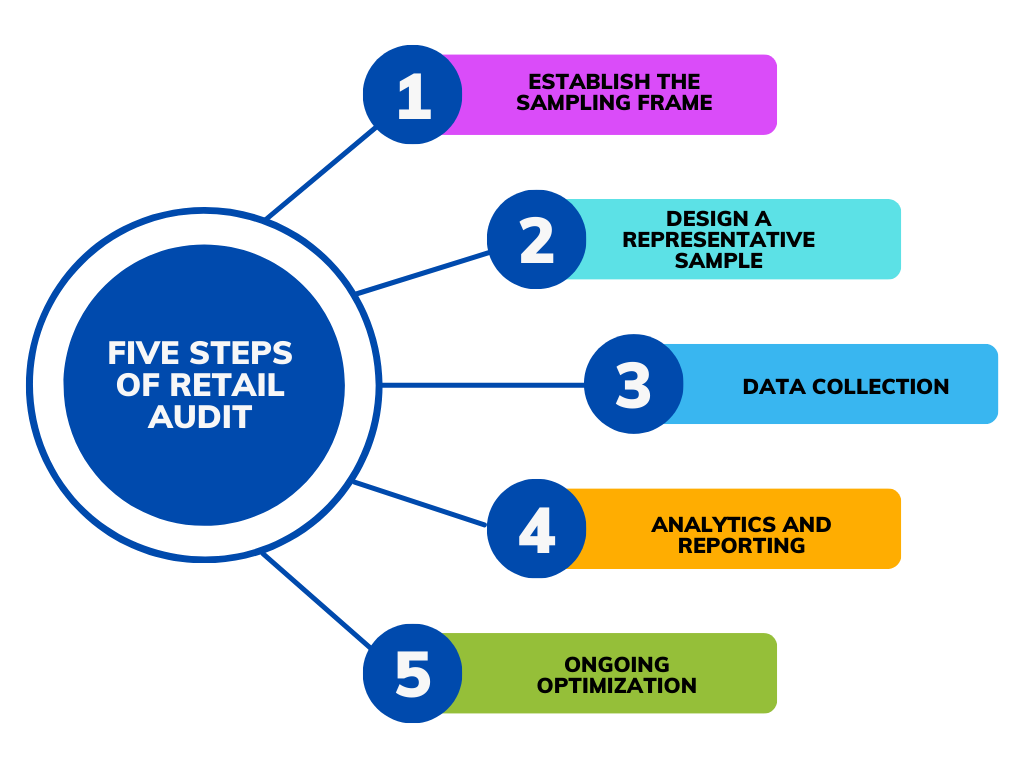Retail Audit Research
What is a Retail Audit? Retail audit is a type of market research method that involves collecting information directly from retail stores about the performance, display, promotion, and positioning of brands or products.
It is targeted at the retail outlets (market) through stable relationships with the retailers (owners or store representatives) to gather information about brands or products and every other information.
Broadly, retail audit research is a continuous and independent measurement of sales, prices, distribution, and inventory of new and existing products in the market. It involves an ongoing process of visiting retail stores, systematically collecting data, and analyzing that data to gain insights into how products are performing.
The continuous nature of retail audit research enables companies to monitor changes in market dynamics and quickly respond with adjusted brand and marketing strategies as needed.
The retail audit research is primarily to examine:
• Retail or Trade Market
• Consumer reaction to the brands or products

Types of Retail Audits in Market Research
Merchandising Audit
Merchandising audits are an essential tool used by brands to evaluate and monitor key retail performance indicators for their products.
Such as inventory levels, product condition, stockouts, shelf appearance, and retail price among others. This type of audit measures all these metrics and how frequently they are implemented.
Retail Promotions Audit
Retail promotions audit is a focused study conducted to evaluate the performance and effectiveness of promotional activities for a specific product or product category.
This type of audit factors in parameters like discounted pricing, in-store displays, promotional type and effectiveness, product SKUs, and sales numbers. The insights obtained are used to inform future promotional strategies.
Loss Prevention Audits
Loss prevention audits assess retailers’ compliance with established processes, training programs, and policies that are designed to reduce vulnerabilities of in-store operations.
These audits evaluate whether employees follow proper protocols around inventory handling, cash management, facility access, and other aspects of store management.
Competitive Analysis Audits
Competitive analysis audit is a complete evaluation of key competitors across critical areas such as pricing strategies, brand positioning, product range, and brand equity to discover potential threats as well as opportunities relative to the focus brand.
The goal of the evaluation is to analyze the competitive landscape to identify vulnerabilities as well as strengths of leading competitors compared to the focus brand.
Key metrics assessed tend to include market share, sales growth, customer loyalty and retention, brand awareness and perception, price points, product differentiation, operational efficiency, and time-to-market with new offerings.
The Five Steps of Retail Audit

1. Establish the sampling frame
Identify the stores and outlets that stock and sell the product categories of interest (retail trade). Gather data on the number and type of retail outlets in your sampling audits (for instance small and large footprint stores, supermarkets), geographic spread, and sales turnover to establish the full retail landscape and parameters for sampling.
2. Design a representative sample
Determine the optimal representative sample size and specification using statistical modelling. For instance, how many of each type of outlet needs to be visited to be able to accurately project findings to the broader retail landscape within a certain margin of error? Sample specification also details which stores to include.
3. Data collection
Determine what data to collect and which collection system is most practical and effective. For manual audit checklists, photos can be taken for later analysis, technology-enabled in-store devices can be used, electronic point-of-sale queries, and so on. All may be done based on the resources, time and precision required. Protocols are required to consistently collect the required metrics across the sample.
4. Analytics and Reporting
Process and analyze the raw audit data obtained to produce regular reports and insights. Overall findings are projected to the established sample frame. Results should include information on opportunities, challenges, trends and recommendations for action.
5. Ongoing Optimization
Continuously refine the audit procedure, including adjusting the sample to account for store openings/closures, adding metrics for new data requirements, and improving the audit system based on results. This ensures it continues to deliver robust, reliable insights.
Benefits of Retail Audit Research
Retail audit holds numerous benefits as it can assist retailers in improving their bottom line If executed successfully.
Some of these include sales maximization, improved market share, benchmarking brand image performance with respect to competitors, analyzing shopper’s behaviour and most importantly providing actionable insights into operational efficiencies.
Let’s take a look at some of the benefits mentioned above:
Increased Profitability and Market Share
Retail audit research data enable brands to monitor their success in the retail space, make the necessary adjustments, and offer suggestions for improvements. Be it in customer experience, product layout, or store operations, all of which boost sales and profitability.
Gain Better Understanding of Customer Behavior
Retail audits give you insights into who your customers are, how often they shop, and their purchasing habits. This promotes a deeper understanding of retail customer behaviour and allows retailers to tailor their products to customer needs.
Optimize Store Operations
Retailers can improve critical store operations by leveraging retail audit data. Specifically, it reveals key insights in inventory management, such as when to replenish products based on sales and stock data. Also, it enables better product placement by revealing customer buying habits.
Additionally, retail audit data exposes breakdowns in the shopping journey which, when addressed, improve customer satisfaction.
At Webhaptic Intelligence, we are at the forefront of providing crucial retail audit research and insights to brands in emerging markets in Africa. As an established market research leader on the continent, we enable retailers to transform their operations using real shopper data.
Our teams are experts in using retail audit techniques to capture actionable information. We identify opportunities for better inventory and supply chain management, effective merchandising tactics and improved in-store customer experiences.
To obtain a quote or proposal for a retail audit in Nigeria, send an email to info@webhaptic.com

